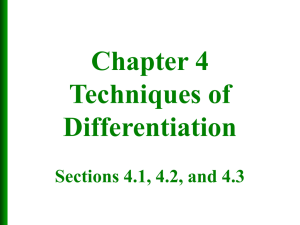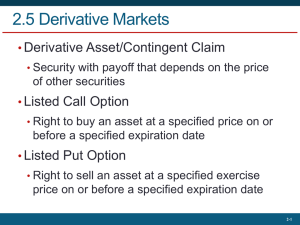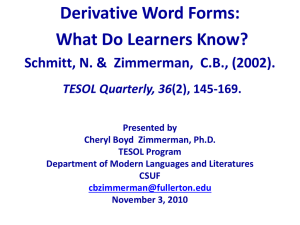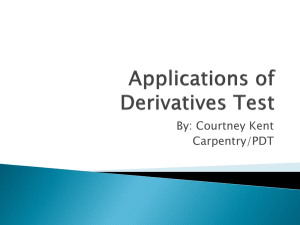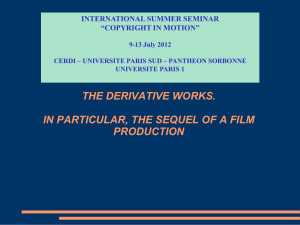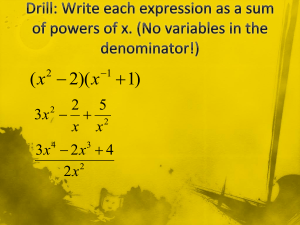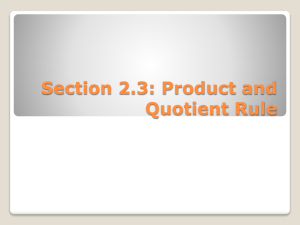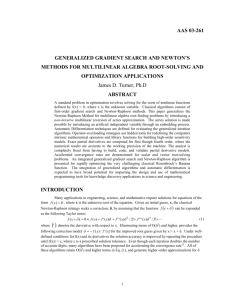2.3 The Chain Rule and Non
advertisement
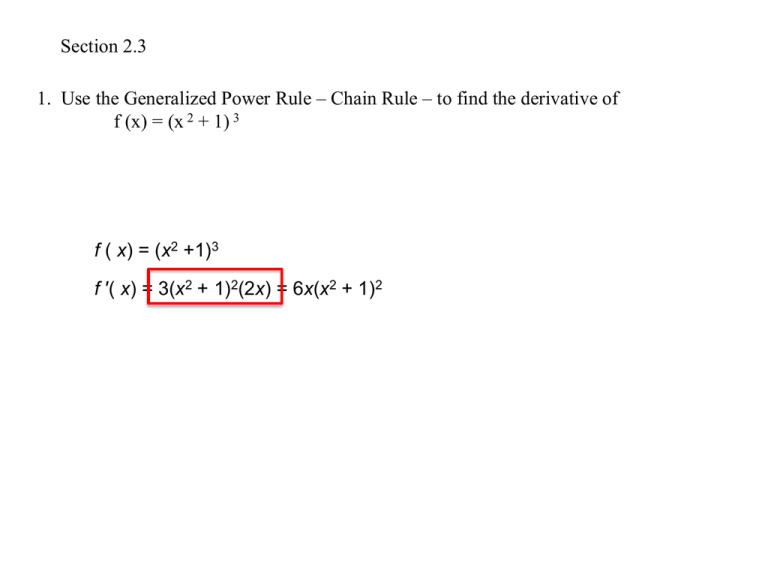
Section 2.3 1. Use the Generalized Power Rule – Chain Rule – to find the derivative of f (x) = (x 2 + 1) 3 f ( x) = (x2 +1)3 f ′( x) = 3(x2 + 1)2(2x) = 6x(x2 + 1)2 2. Use the Generalized Power Rule – Chain Rule – to find the derivative of f (x) = (3x 2 – 5x + 2) 4 f (x) = (3x2 − 5x + 2)4 f ′( x) = 4(3x2 − 5x + 2)3 (6x − 5) 3. Use the Generalized Power Rule – Chain Rule – to find the derivative of f (x) f (x) 3 f '(x) 3 9x 1 9 x 1 (9 x 1) 1 3 (9 x 1) 2 3 1 3 (9 ) 3 (9 x 1) 2 3 4. Use the Generalized Power Rule – Chain Rule – to find the derivative of f (x) = (4 - x 2 ) 4 y = (4 − x2 )4 y ′ = 4(4 − x2 )3(−2x) = −8x(4 − x2)3 5. Use the Generalized Power Rule – Chain Rule – to find the derivative of f (x) = x 4 + (1 – x ) 4 y = x 4 + (1 − x)4 y ′ = 4x3 + 4(1 − x)3(−1) = 4x 3 − 4(1− x)3 6. Use the Generalized Power Rule – Chain Rule – to find the derivative of 1 f (x) 3 1 f (x) 3 f '(x) (9 x 1) 2 3 (9 x 1) (9 x 1) 2 2 3 2 (9 x 1) 5 3 (9 ) 6 (9 x 1) 5 3 7. Use the Generalized Power Rule – Chain Rule – to find the derivative of f (x) = [ (x 2 + 1 ) 3 + x] 3 f ( x) = [(x2 +1)3 + x]3 f ′( x) = 3[( x2 + 1)3 + x]2 dy/dx[(x2 + 1)3 +x] = 3[( x2 + 1)3 + x]2 [3(x2 + 1)2 (2x) +1] = 3[( x2 + 1)3 + x]2 [6x(x2 + 1)2 + 1] 8. Use the Generalized Power Rule – Chain Rule – to find the derivative of f (x) = (2x + 1) 3 (2x – 1) 4 Product Rule and Chain Rule combined. f ( x) = (2x + 1)3(2x − 1)4 f ′( x) = (2x + 1)3[4(2x − 1)3(2)] + (2x − 1)4 3(2x + 1)2 (2) f ( x) = 8(2x + 1)3(2x −1)3 + 6(2x + 1)2(2x −1)4 9. Use the Generalized Power Rule – Chain Rule – to find the derivative of x 1 f (x) x 1 3 2 x 1 ( x 1)(1) ( x 1) (1) f '(x) 3 2 ( x 1) x 1 Quotient Rule Chain Rule 2 2 x 1 2 6 ( x 1) f '(x) 3 2 2 ( x 1) x 1 ( x 1) You could also do this problem as a product rule by rewriting it as: f (x ) (x 1) (x 1) 3 3 10. BUSINESS: Cost - A company’s cost function is given below in dollars, where x is the number of units. Find the marginal cost function and evaluate it at 20. C (x) 4 x 900 2 The marginal cost function is the derivative of the function C (x) C (x ) (4x 900) 2 C '(x) 1 1 2 (4 x 900 ) 2 1 2 (8 x ) 4 x (4 x 900 ) 2 1 2 2 C ' (20) 4 (20)[4(20) 900] 2 1 2 1.6 Since you are trying to calculate a derivative at a point you may use your calculator. Graph the original cost function and go to the derivative menu. Do you know what the 1.6 means???? 11. SOCIOLOGY: Income Status – A study estimated how a person’s social status (rated on a scale where 100 indicates the status of a college graduate) depends upon income. Based on this study, with a an income of x thousand dollars, a person’s status is given by S (x) = 17.5 (x – 1) 0.53. Find S ’ (25) and interpret your answer. S(x) = 17.5(x −1)0.53 S ′ (x) = 9.275(x −1) −0.47 S ′ (25) = 9.275(25 − 1) −0.47 ≈ 2.08 At an income of $25,000 social status increases by about 2.08 units per additional $1000 of income. Since you are trying to calculate a derivative at a point you may use your calculator. Graph the original cost function and go to the derivative menu. This is a graph of the original equation S(x). 12. BIOMEDICAL: Drug Sensitivity – The strength of a patient’s reaction to a dose of x milligrams of a certain drug is R (x) = 4x (11 + 0.5 x) 0.5 for 0 ≤ x ≤ 140. The derivative R‘ (x) is called the sensitivity to the drug. Find R‘ (50), the sensitivity to a dose of 50 milligrams of the drug. R ( x ) 4 x (11 0 . 5 x ) 0 .5 You need to use the product rule! R ' (x ) (4x ) 0.5 (11 0.5 x ) x (11 0.5 x ) R (50 ) 50 (11 25 ) 0.5 0.5 0.5 (0.5) 4 (11 0.5 x ) 4 (11 0.5 x ) 4 (11 25 ) 0.5 0.5 50 6 Since you are trying to calculate a derivative at a point you may use your calculator. Graph the original cost function and go to the derivative menu. 0.5 4 6 32.33 13. ENVIRONMENTAL SCIENCE: Pollution – The carbon monoxide level in a city is predicted to be 0.02 x 2/3 + 1 ppm (parts per million), where x is the population in thousands. In t years the population of the city is predicted to be x (t) 12 + 2t thousand people. Therefore, in t years the carbon monoxide level will be P 9t) = 0.02 (12 + 2t) 3/2 + 1 ppm Find P ‘ (2), the rate at which carbon monoxide pollution will be increasing in 2 years. P(t ) = 0.02(12 + 2t)3/2 + 1 P′ (t ) = 0.03(12 + 2t ) 1/2 (2) = 0.06(12 + 2t) 1/2 P′ (2) = 0.06[12 + 2(2)]1/2 = 0.24 Since you are trying to calculate a derivative at a point you may use your calculator. Graph the original cost function and go to the derivative menu. 14. For the following function below, find the x-values at which the derivative does not exist. The derivative does not exist at the corner points, end points or gaps: x = − 3, 1, 4. 15. Why is the following function not differentiable at x = 0? f (x) = x 2/3. Graph the function on your calculator. There is a corner point at x = 0.


